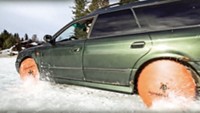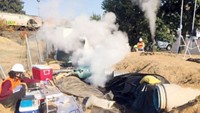Advertisement
Grab your lab coat. Let's get started
Welcome!
Welcome!
Create an account below to get 6 C&EN articles per month, receive newsletters and more - all free.
It seems this is your first time logging in online. Please enter the following information to continue.
As an ACS member you automatically get access to this site. All we need is few more details to create your reading experience.
Not you? Sign in with a different account.
Not you? Sign in with a different account.
ERROR 1
ERROR 1
ERROR 2
ERROR 2
ERROR 2
ERROR 2
ERROR 2
Password and Confirm password must match.
If you have an ACS member number, please enter it here so we can link this account to your membership. (optional)
ERROR 2
ACS values your privacy. By submitting your information, you are gaining access to C&EN and subscribing to our weekly newsletter. We use the information you provide to make your reading experience better, and we will never sell your data to third party members.
Consumer Products
Subaru blames silicones for switch glitch
Volatile compounds, possibly from cleaning products, make some brake-lamp switches fail
by Bethany Halford
March 13, 2019

Automaker Subaru plans to voluntarily recall certain models of its Crosstrek, Forester, and Impreza vehicles because of what they describe as a reaction between silicone-containing consumer products and brake-light switches. The recall will affect 1.3 million automobiles in the US alone, according to Dominick Infante, director of corporate communications for Subaru of America.
Vehicles with the faulty switches run the risk of having the brake lights fail. The brakes will still function, but the problem increases the risk of being rear-ended. So far, Infante says, there have been only 33 reports of the brake-lamp switches failing.
Infante says Subaru discovered the brake-light switch snafu, which “stems from the use of consumer products containing silicone that can seep into the brake lamp switch housing and deposit a layer on the switch contact.” This causes the switch to lose conductivity, resulting in non-working brake lights. Consumer products containing silicones include shampoo, fabric softener, and skin-care products.
Manoj Chaudhury, an expert in silicones at Lehigh University, says the explanation seems reasonable. Although Chaudhury says he can’t comment specifically on what’s happening with Subaru’s switches without examining them, he says he’s observed a similar phenomenon in his lab. Chaudhury has found that electrodes inserted into a mixture of oil and water can fail over time. He thinks the oil reacts to form an insulating layer on the electrodes, and he expects something similar would happen with silicones. Silicones have a special affinity towards most surfaces because their surface tension is low and the molecules are flexible. Silicones “can creep over most surfaces easily,” he says. Chaudhury, who owns two Subarus, says he’s interested in learning more about what’s happening with the automaker’s switches.
“Silicones, as a source of volatile oligomeric species, could generate a high contact resistance,” says Ralph Nuzzo, who studies the surface properties of electrochemical materials at the University of Illinois, Urbana-Champaign. Nuzzo also says he can’t comment specifically on what’s happening with the brake-lamp switches, but he suspects that the if the voltages are high enough in the switch circuits, an electrical discharge in the air could oxidize silicon in the silicones to form silica-like materials.
But Nuzzo finds one thing puzzling. “Silicones are everywhere, used in all kinds of commercial products and all sorts of places based on engineering requirements,” he says. They’re in sealants, adhesives, anti-fog coatings, and insulators. How is Subaru so sure that the silicones are coming from consumer products? “That would be utterly difficult to prove, it seems to me,” Nuzzo says. “Wouldn’t one want to know how and where silicones may have been used or integrated as material components during the manufacturing process?” How did the automaker rule out a source of the volatile species inside the car?
Subaru’s Infante says silicon dioxide was found on the contact surface of the brake lamp switches. “Furthermore, the investigation found there to be no products containing silicone used in the manufacturing process of any related parts,” he adds. That’s why Subaru thinks that consumer products containing silicone are the culprit in the switch glitch.
Advertisement
Subaru will contact owners of affected vehicles within the next 60 days.




Join the conversation
Contact the reporter
Submit a Letter to the Editor for publication
Engage with us on Twitter